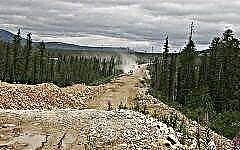
"Road" in the minds of the Slavs is an ambiguous concept. We call this word any place where you can walk or drive. And we say that we are going on the road, implying not a specific route, but the journey itself - it does not matter where and in what way.
When it comes to the most extreme roads in Russia, it is better to rely on the opinion of foreigners, because it is difficult to scare the locals with something. What seems to foreign guests to be a life-threatening adventure, is a common thing for a Russian person.
So, here are some of the most "terrible" Russian roads, which foreign travel agencies recommend to look only to optimists looking for adrenaline. Fasten your seat belt before embarking on any of these routes.
The old road to Krasnaya Polyana "Lord, carry it!"

Krasnodar Territory, an abandoned crooked road through the mountains and the Akhtsu gorge. Before the creation in 2005 of a new tunnel linking Adler with the resort village of Krasnaya Polyana, travelers had to travel along this extreme rocky serpentine. The path cut along the edge of the cliff, put into operation at the end of the 19th century, was the only way of communication between the above points and was actively used until the beginning of the 21st century.
Today it is difficult to get there, but extreme people manage to make their way. Just 15 years ago, life was in full swing here, and now only the exit to the left of the Akhtsu tunnel leads to an abandoned road teeming with dangerous turns. Vehicles are prohibited from driving, and in view of the numerous landslides, it is simply impossible. It is curious that the arched structures, partially protecting from rockfalls, were erected only in the 2000s - shortly before the closure of the route.
Local weather brings surprises in the form of unexpected fogs and rains, eroding areas to the point of impassability; in winter there is a lot of snow. The rocks hang directly overhead, stones fall from them, threatening life and blocking the passage, and below there is an abyss with a raging river.
Only one thought will beat in your head - "If only everything worked out!" (by the way, no kidding, the road is called - "Lord, carry it!"). On the roadside there are monuments to the fallen travelers, there is even a monument to the soldiers of the Red Army who were executed by the White Guards in the civil war. Today the road has dried up, but it still beckons thrill seekers - deadly and terribly beautiful.
Kolyma highway (P504, Far East)

The Kolyma highway is one of the main roads in the Far Eastern region. Highways were laid by prisoners of Stalin's camps, and the remains of those who died during construction were “buried” in the roadbed - this gave rise to the terrible name “Road of Bones”. Without a rail link, it remains the only major land route to and from Yakutsk and is considered one of the deadliest in the world.
The road services are trying to keep it passable, but it is still full of dangers. Traffic has improved significantly thanks to several modernization projects in recent years, where the track has been widened and asphalted in places, fencing and efficient drainage have been added. But some areas to this day are in a terrible state and require strong nerves from those who want to overcome them.
In summer, sharp stones cut tires, and clouds of dust billowing up from trucks make it virtually impossible to see. During the rainy season, the terrain is heated, in some places traffic is completely paralyzed due to deep viscous mud and occasional deep pits, where you can easily lose a wheel.
In cold weather, the movement improves if there is no heavy snowfall. However, the temperature is dropping so much that lonely adventurers risk freezing to death in a broken car, and going in search of help - become food for wild animals that abound in the wilderness of the Far East. Sadly, deaths are common here.
Russia could do something about it. After all, America built the Alkan Highway in Alaska under similar conditions. Construction crews have built a modern 4-lane freeway across the permafrost that operates all year round. However, it requires money and effort - neither the one nor the other Russian government is willing to spend on roads, which, as it believes, and so it is possible to drive.
Vitimsky (Kuandinsky) bridge, Transbaikalia

One of the scariest road bridges in Russia, if not all over the world. Located on the border between Buryatia and the Trans-Baikal Territory, this structure, which is part of the famous BAM, passes through the Vitim River near a parallel railway line.
Its width is almost equal to that of a vehicle, and daredevil drivers (including those on trucks!) Are forced to balance at a height of 20 meters without a safety rail. In winter, the bridge becomes even more treacherous as the flooring becomes icy and the tires struggle to find traction.
The 560-meter ferry was originally built as a temporary one, but continues to operate: the authorities have not yet provided drivers with an alternative. From year to year, they cross Vitim at their own peril and risk - even after the recent collapse of one of the pillars and the terrible state of the canvas, along which it’s scary to walk on foot, let alone ride.
Many drivers pray before heading to the other side of the river. The passage is extremely narrow and completely devoid of fencing, and trucks, under which the beams are shaking, risk falling into the water boiling between the piles every second.
The columns supporting the structure are covered with rust, and the wooden sleepers that form the flooring are dilapidated and broken, so that even the slightest mistake can be fatal. An equally extreme country road leads to the eerie Vitimsky Bridge, passing through wild places through forests and swamps, far from rescuers, gas stations and car repair shops.
The road between Akhty and Khnov (Dagestan)

Another "road of death" that only the most fearless can overcome. Part of the historically important road with strategic importance Kazikumukh-Kurakh-Akhty-Khnov-Nukha. Narrow and winding, it is especially dangerous after rains, which make it very slippery and cause loosening of the soil on the hillsides and rockfalls.
The situation is complicated by fog, which makes it difficult for drivers to clearly see the curbs and oncoming traffic. Sometimes you are forced to move on the left side, sometimes on the right, in some places you generally crawl blindly through a veil of rain or dust with zero visibility, and each time you do not know whether oncoming motorists will let you through.
Dozens of cars crash on this road every year, and fatalities are not uncommon, although the issue of transport communications in this area is under special control of the authorities.
Crimean road on the mountainous relief of Ai-Petri

There is nothing like a relaxing ride on a smooth highway with pleasant music. And there is nothing worse than falling off a cliff, because you missed a sharp turn.
The 23-kilometer section of the road in the Crimean south is part of the Yalta-Bakhchisarai highway. In winter, driving on it is fraught with a risk to life, but when there is no snow, be careful and everything will go fine. It only takes patience and concentration to overcome a long series of turns.
In bad weather it is better to stay at home - the rain makes the roadway slippery, and the dense fog that is often in these parts makes you feel blindfolded. This route is definitely not for beginners - inexperienced drivers should not drive on any mountain roads, especially at night.But they are still drawn here, which is not surprising - the local natural landscapes are indescribably beautiful at any time and weather.
Caucasian mountain road

A narrow winding path connecting Lake Ritsa and Sochi passes through the majestic mountains of the Caucasus region. Traveling along this road is an extreme adventure that is both exciting and daunting. Although the locals do not think so, doing it at least once a week.
The track is known for its difficult, sharp turns and a series of bends under the mountain slopes on one side and bottomless abysses on the other. To reach your destination without any problems, you will need truly stellar driving skills, nerves of iron and a solid car.
Trans-Siberian highway

Trans-Siberian highway is one of the longest in the world: over 11 thousand kilometers in difficult weather and terrain conditions. The sections range from fairly good highways in the west to broken roads with poor coverage in the east. For most of the year, conditions are normal, but in the warm, humid summer, some places turn into an impenetrable mud swamp.
Due to its unique location and travel through remote areas, it is important to be prepared to drive in these conditions. The highway is not easy, it crosses all conceivable landscapes - from lush forests to harsh tundra and endless expanses in the icy void.
For the most part, the trip is uneventful, but there are sections that give rise to bad feelings and require caution. Traffic is also unpredictable, in places cars are rare and often in poor condition. Expect dangerous overtaking, speeding and other recklessness.
The dirt section of the Siberian section runs through a sparsely populated area, away from help, grocery stores and gas stations. Seasoned drivers prefer not to drive this road alone.
Sulak canyon

One of the most picturesque natural attractions of the Republic of Dagestan is Sulak, the deepest canyon in Europe and one of the deepest in the world. Its length is 53 kilometers and its depth reaches 1920 meters - about 60 meters deeper than the famous American Grand Canyon.
This is one of the most popular tourist sites in Dagestan (albeit unofficial) and at the same time one of the most dangerous places - a narrow path without the ability to turn around, high sharp rocks, strong wind and the absence of fences. At the entrances, the roads are ordinary, but a serpentine winds along the canyon itself, on which you can go crazy with fear. Many tourists are looking for new emotions here, even if they know how dangerous it is.
Conclusion
According to all experienced drivers, there is no road that can guarantee absolute safety. Russia is a huge country, and only about 10% of the total highway network is considered "good quality".
There are places where roads are dangerous due to weather or geological conditions. There are “conditional” roads that can easily swallow a tank. It is not surprising that the locals have a joke, they say, there are no roads in Russia - only directions. The climate is harsh, summer heat can melt asphalt, and winter ice cuts even powerful spiked tires. Road workers often create havoc by undertaking construction or repairs during peak hours.
In permafrost regions, many major arteries do not have asphalt coverage at all, although they are vital federal highways. Putting a proper cover there is problematic, and it turns into mush as soon as the snow melts.
“It's amazing,” foreigners say, “how people can live and work here, since traffic on many roads is simply impossible. They are often in such poor condition that they make you wonder if they were deliberately spoiled for fear of an enemy invasion. "
To tell the truth, Russians are not afraid of anyone, they are just used to difficulties. They love Russia in all its manifestations and consider it an exceptional place that never ceases to fascinate those who are fortunate enough to explore it. In this context, safe and solid roads are not the main thing. Much more important is the passion for travel, after which it is so pleasant to return home. Of course, with a heap of memories of adventures on the country's most extreme roads!

|| list |
- Old road to Krasnaya Polyana
- Kolyma highway (P504, Far East)
- Vitimsky (Kuandinsky) bridge, Transbaikalia
- The road between Akhty and Khnov (Dagestan)
- Crimean road on the mountainous relief of Ai-Petri
- Caucasian mountain road
- Trans-Siberian highway
- Sulak canyon











